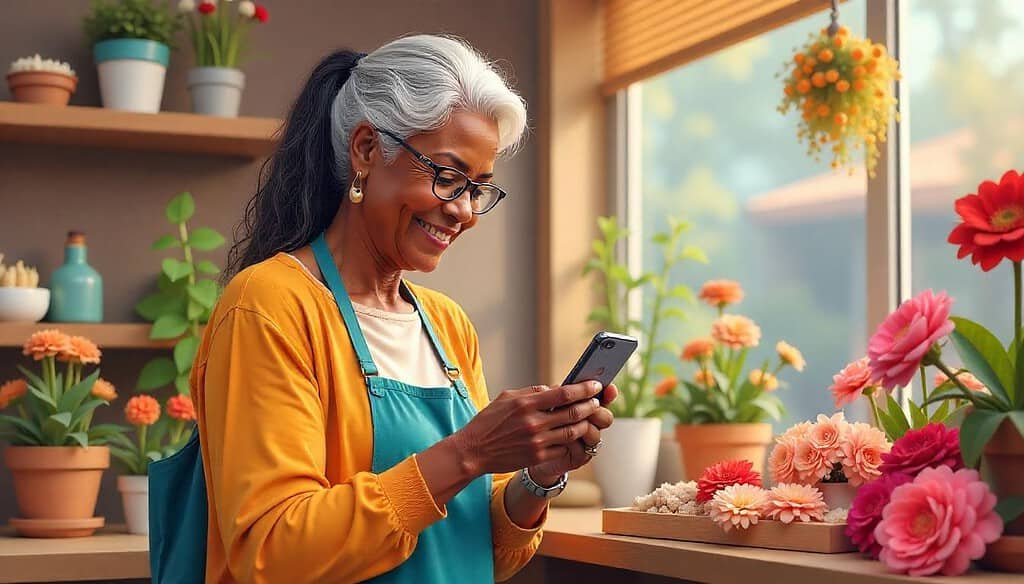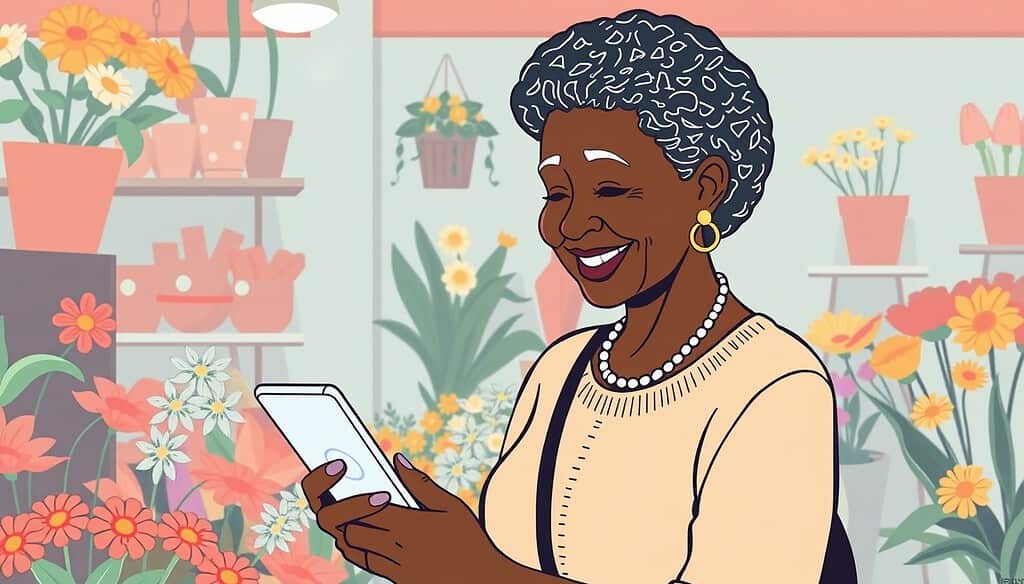Table of Contents
Aged People and Technology

Technology has become an increasingly positive influence in the lives of aged people, offering tools that bring convenience, connection, and empowerment. As digital devices, mobile apps, and wearable health gadgets become more accessible, aged people are finding new ways to stay in touch with family, engage with friends, and enrich their daily routines. Many older adults have embraced smartphones and tablets, enjoying how these devices enable them to communicate with loved ones regardless of distance, share photos, or catch up with family news.
With easy access to information and entertainment, aged people can now learn about topics of interest, follow their favorite programs, or explore new hobbies online, all from the comfort of home. Wearable health technology, like fitness trackers or blood pressure monitors, provides aged people with tools to stay active and manage their well-being, creating a sense of control and independence. Furthermore, technology has opened doors to a wealth of resources that promote mental engagement, from brain-training apps to online classes in art, language, or history. Virtual reality and augmented reality are even allowing aged people to experience travel or cultural events in ways that were once out of reach, adding excitement and exploration to their lives.
Digital advancements also support lifelong learning, with many older adults discovering new skills in tech, whether through online tutorials or local community workshops. This knowledge broadens their world and encourages them to interact with digital tools confidently. Overall, technology is empowering aged people to enjoy a richer, more connected life, bridging generational gaps, and fostering inclusivity in a digital age. As they embrace these advancements, aged people are redefining what it means to age in a modern world, enjoying all the benefits that technology brings.
Aged People and Smartphones

Smartphones have become a transformative tool in the lives of aged people, bringing convenience, safety, and connection to their daily routines. With smartphones, aged people now have access to an array of applications that support health, communication, and leisure, empowering them to stay informed and engaged. Health apps, for instance, provide reminders for medications, monitor vital signs, and track physical activity, which promotes well-being and encourages healthy habits. Additionally, GPS navigation helps aged people feel more confident and independent when traveling, while emergency alert features add an extra layer of safety, ensuring help is just a tap away.
Smartphones also serve as a valuable bridge for aged people to remain socially active and connected with family and friends. Through video calls, messaging apps, and photo-sharing platforms, they can participate in family gatherings or celebrations, even when miles apart. This connectivity combats isolation, fostering a sense of belonging and emotional support. With voice-assisted technology, smartphones have become easier to use as well; aged people can make calls, set reminders, and search the internet with simple voice commands, simplifying daily tasks and making technology more accessible. Social media, meanwhile, has opened doors for aged people to join online communities, participate in group discussions, and pursue interests like gardening, reading, or cooking alongside others who share their passions.
Beyond communication and safety, smartphones enable aged people to continue exploring and learning. With mobile access to news, articles, and educational videos, aged people can stay informed about current events and pursue lifelong learning. Many have taken to exploring new hobbies or revisiting old ones through tutorials available on platforms like YouTube or specialized apps. Audiobook and podcast apps also provide on-demand access to entertainment and enrichment, allowing them to enjoy stories, lectures, or guided meditations at their own pace.
Ultimately, smartphones are redefining aging by supporting independence, encouraging social interaction, and expanding possibilities for learning and personal growth. They allow aged people to tailor technology to their individual needs, interests, and lifestyles, enhancing both convenience and quality of life. This access to information, connection, and safety empowers aged people to stay active, curious, and engaged, proving that smartphones are not just devices but gateways to a more enriched, connected, and fulfilling experience in the modern world.
8 Big Ways Smartphones Are Helping Aged People

1. Health Monitoring and Reminders
Smartphones have transformed health management for aged people by integrating tools and apps designed to monitor well-being and support daily health routines. Health apps on smartphones offer a range of features, including the ability to record physical activities, measure heart rate, track sleep, and set reminders for medication schedules. These features allow aged people to manage their health independently and help them maintain regular routines that are crucial for well-being.
For instance, aged people can set alarms for specific medication times, ensuring they do not miss doses and can maintain a consistent treatment regimen. Beyond medication, reminders can also be set for daily hydration, physical therapy exercises, or any other activity that supports their health. By providing a structured way to remember health tasks, these reminders encourage habits that are vital for physical and mental wellness
Smartphones equipped with health sensors, like heart rate monitors and oxygen saturation tracking, provide aged people with real-time insights into their vital signs. This functionality empowers them to detect any irregularities early and take action if something appears unusual. Many health apps also offer the option to record daily measurements, which can be reviewed over time to monitor trends or discuss with healthcare providers during appointments.
This capability supports proactive health management, as aged people can keep track of key health indicators without frequent clinic visits. In cases where wearable devices are connected to smartphones, such as fitness bands or smartwatches, these devices can sync data directly to health apps, creating a seamless way to capture a range of vital metrics that help aged people stay informed about their physical condition.
For those managing chronic conditions, smartphones provide easy access to health-related information and can even be used to participate in virtual consultations. Telemedicine has gained popularity, allowing aged people to consult healthcare professionals from home. This is especially beneficial for those with limited mobility or those who live far from healthcare facilities.
Telemedicine apps, supported by smartphone technology, enable them to discuss symptoms, receive advice, and gain reassurance without needing to make in-person visits. This not only saves time but also reduces the physical and mental strain often associated with hospital trips. In this way, smartphones serve as a health hub for aged people, giving them tools to monitor, record, and manage their health effectively, ensuring they have continuous and convenient support in their wellness journeys.
2. Enhanced Communication
The communication capabilities of smartphones have proven to be transformative for aged people, helping them maintain strong connections with family, friends, and social communities. Messaging apps, video calling platforms, and social media have given aged people accessible ways to keep in touch with loved ones regardless of geographic distance.
Video calls, in particular, have become an invaluable resource for aged people who may not be able to visit family frequently. Through video, they can see and interact with grandchildren, siblings, and friends, sharing in family moments that once may have been out of reach. This visual connection adds a layer of warmth and presence that is especially beneficial for aged people who might feel lonely or isolated. Messaging apps, on the other hand, allow for quick, frequent check-ins and the exchange of photos or daily updates, helping aged people feel consistently engaged with their families’ lives.
Social media has also opened up new avenues for aged people to stay connected and engage with their communities. Many older adults use social platforms to keep up with events, join groups related to their hobbies, or reconnect with old friends and acquaintances. Through social media, aged people can participate in discussions, share their thoughts, and enjoy the sense of community that comes from being part of an online group.
For those who may have limited in-person social interactions, this online community provides a vital source of social engagement, offering the opportunity to learn from others, stay socially active, and develop new friendships. Many aged people have taken to sharing photos, memories, and life updates, creating a bridge between generations as younger family members enjoy seeing glimpses of their elders’ lives.
Moreover, smartphones have allowed aged people to stay in close contact with healthcare providers and caregivers. Many messaging and video apps are used not only for personal conversations but also for regular check-ins with healthcare professionals, where they can ask questions, discuss health updates, or share information about any health concerns. This accessibility supports aged people’s health and safety, as it encourages open communication between them and their care teams.
Additionally, some families have set up group chats with caregivers, allowing everyone involved in an aged person’s care to stay updated and work together to ensure their well-being. In this way, smartphones extend beyond simple communication, serving as a tool that facilitates connection, support, and community engagement in ways that enrich the lives of aged people.
3. Safety and Emergency Features
Safety is another area where smartphones have become invaluable to aged people, providing peace of mind and a sense of security. Smartphones are equipped with various emergency and safety features, which can be lifesaving in critical moments. One of the most significant is the emergency SOS function, available on many smartphones, which allows aged people to quickly alert designated contacts or emergency services if they are in need. By simply pressing a specific button sequence, they can immediately send out an alert along with their location, enabling loved ones or first responders to reach them promptly. For those who may have health conditions or live alone, this feature offers essential reassurance, ensuring that help is never far away.
GPS functionality on smartphones also supports the safety of aged people by enabling family members or caregivers to track their location when necessary. This is particularly beneficial for aged people who may have memory concerns, as it provides a safety net for instances where they may become disoriented or lost. With location-sharing, aged people can go about their day more independently while their loved ones have peace of mind knowing they can locate them if needed. Some families even use smartphone apps designed for location tracking specifically to support the safety of aged family members, setting up geofencing alerts that notify them if their loved one stray beyond a designated area.
Many smartphones are also compatible with wearable devices, like fall-detection pendants, which alert caregivers in the event of a fall or sudden movement. When synced with a smartphone, these devices can instantly notify family members or healthcare providers, who can respond quickly to assist the person in need. In addition, smartphones can store important health information, like medical conditions, allergies, and emergency contact details, which can be accessed by first responders in case of an emergency. For aged people, knowing that this information is readily available can provide a sense of security and control over their health situations.
Smartphones also allow aged people to engage with various safety and wellness apps, from those that track movement and activity to apps that provide mental health support. Some apps include daily check-ins or prompts that encourage aged people to stay active and connected, reminding them to reach out if they need assistance. By offering tools that combine convenience with security, smartphones are helping aged people feel safe and supported, promoting both their physical safety and their confidence as they navigate their daily lives.
4. Access to Information and Learning
The access to information and learning that smartphones provide has opened new opportunities for aged people, allowing them to remain mentally active, informed, and engaged with the world around them. With just a few taps, aged people can read news articles, explore hobbies, learn new skills, and stay updated on topics that interest them.
This access encourages a habit of lifelong learning and mental stimulation, as aged people have endless resources available to them, from educational websites to video platforms. For instance, aged people interested in cooking can look up recipes, follow video tutorials, or even join virtual cooking classes, helping them explore their culinary interests at their own pace. For many older adults, this opportunity to explore their interests from home adds both enjoyment and variety to their lives
Smartphones are also valuable for aged people who want to stay updated on current events and issues. Through news apps, podcasts, and digital newspapers, they can remain informed about politics, science, culture, and global events, which supports intellectual engagement and connects them with broader social conversations. Access to information has also become essential for managing health, as aged people can research health topics, look up symptoms, or find information on managing specific conditions. This empowerment to understand health matters allows them to have more informed discussions with healthcare providers, ask relevant questions, and feel more engaged in their own healthcare.
Learning opportunities on smartphones extend beyond reading and viewing. Aged people can also access apps designed for brain training and cognitive health, which have become popular tools for mental exercise. Games and puzzles designed to stimulate memory, focus, and reasoning can be played daily, helping aged people keep their minds sharp while enjoying the challenge. These apps offer a convenient way to engage in cognitive activities, which can be especially helpful for those who want to support their mental health proactively. Some aged people have also taken to learning new languages or skills, utilizing language-learning apps or platforms that offer lessons in subjects like art, history, and technology.
Additionally, smartphones allow aged people to connect with online communities and participate in digital classes. Many institutions and organizations offer virtual courses specifically designed for older adults, covering subjects from history and literature to music and philosophy. By joining these online learning groups, aged people can interact with peers who share their interests, exchange ideas, and find a sense of camaraderie in a shared learning experience. Through these digital resources, aged people can continue exploring and expanding their knowledge, fostering curiosity, and staying intellectually engaged in meaningful ways.
5. Voice Command and Accessibility Features
Voice command technology and accessibility options on smartphones have made it easier for aged people to engage with technology, simplifying various daily tasks. Voice command features allow aged users to perform actions like making phone calls, sending messages, searching the internet, and setting reminders simply by speaking. This hands-free interaction reduces the need to navigate complex interfaces, which can sometimes be challenging due to issues like reduced dexterity or vision limitations.
Voice assistants, such as Siri, Google Assistant, or Alexa, are equipped to respond to a variety of commands, providing convenience and accessibility. For example, aged people can set reminders for tasks like taking medications, watering plants, or calling family members. With a simple verbal command, these actions can be scheduled, allowing them to organize their day with ease
Accessibility settings on smartphones enhance the usability of these devices for aged people. Features like adjustable font sizes, screen magnifiers, and high-contrast modes help accommodate visual impairments, making text and images easier to read. For those with hearing challenges, smartphones often provide options to increase audio levels, enable closed captioning on videos, or pair with hearing aids via Bluetooth.
Moreover, speech-to-text functionality allows aged users to dictate messages or notes without typing, providing an efficient alternative for those who may find on-screen keyboards difficult to use. Additionally, many smartphones include “reachability” settings, which bring the screen content closer to the bottom, allowing aged people with limited hand mobility to access functions more easily.
In recent years, companies have also focused on developing specialized accessibility apps tailored to individual needs. For example, apps like “Be My Eyes” connect visually impaired users with volunteers who can assist them in real time, such as by describing the contents of a letter or guiding them in unfamiliar surroundings. Other apps are designed to help aged people with memory challenges by creating visual or audio cues that help them navigate daily routines.
These accessibility tools contribute to a more inclusive smartphone experience, enabling aged people to interact with technology in ways that respect their individual abilities. By combining voice commands and accessibility features, smartphones have become an essential tool that adapts to the unique needs of aged users, fostering independence and confidence as they manage daily life.
6. Online Shopping and Home Delivery
Smartphones have brought the convenience of online shopping and home delivery services directly to aged people, offering them a practical and efficient way to meet their daily needs without leaving home. Through shopping apps and websites, aged people can order groceries, medications, household items, and more, all from the comfort of their living spaces. This is particularly beneficial for those who may have mobility challenges or prefer to avoid crowded places.
With just a few taps, they can browse products, compare prices, and place orders, enjoying the convenience of delivery services that bring their purchases directly to their doorstep. For example, grocery delivery apps allow aged users to order fresh produce, pantry staples, and household essentials, helping them maintain a stocked kitchen with minimal physical effort
Online shopping is not limited to groceries and essentials; aged people can also explore and purchase items like books, clothing, electronics, and hobbies-related supplies. The variety available through online stores gives aged users a wider selection than they might find locally, helping them find specialized products or brands that suit their preferences. Many online platforms offer recommendations based on past purchases, making it easier to find familiar items without extensive searching. Furthermore, some apps offer “subscribe and save” options, allowing aged people to schedule regular deliveries of essentials like vitamins, pet food, or personal care items. This automated service ensures they never run out of important items and reduces the need for repeated ordering.
The availability of home delivery services extends to medications as well. Many aged people benefit from pharmacy apps that enable them to refill prescriptions and have medications delivered directly. This is particularly helpful for managing chronic conditions, as it eliminates the need for frequent pharmacy visits. Some apps even send reminders when it’s time to reorder medications, ensuring continuity in their treatment routines. Additionally, some online grocery and pharmacy services offer the option to chat with customer service representatives who can assist with product recommendations or address specific needs. For aged people, this personal touch adds to the convenience of online shopping, as they can clarify any questions before placing an order.
In summary, online shopping and home delivery have transformed the way aged people meet their everyday needs, making it easier and more convenient to obtain essentials without physical strain. This technology also provides aged users with a sense of independence, as they can shop, select items, and manage their needs with a few simple actions on their smartphones. The integration of online shopping into daily routines not only enhances convenience but also fosters confidence, knowing that they have reliable access to products and services that support their well-being.
7. Entertainment Options
Smartphones have opened up a world of entertainment for aged people, providing them with endless options to stay entertained, engaged, and mentally stimulated. With access to streaming services, aged users can watch movies, TV shows, documentaries, and even classic films that bring nostalgia and joy.
Video-streaming apps like Netflix, YouTube, and specialized platforms offer a vast library of content suited to various interests. For aged people, this access to on-demand entertainment allows them to unwind with their favorite shows, explore new genres, and stay connected to pop culture or historical series they may enjoy. Additionally, many streaming platforms offer subtitle options, making content more accessible for those with hearing challenges
Music and audio-streaming services, such as Spotify and Apple Music, provide another dimension of entertainment. Aged users can listen to music that brings back memories, explore different genres, or enjoy playlists that suit their moods or activities. Many aged people have embraced podcasts as well, finding enjoyment in audio programs that cover topics ranging from history and science to storytelling and humor.
These audio services are particularly appreciated by aged people who may want entertainment during walks, exercise, or while relaxing at home. Furthermore, some aged people enjoy using audiobook services like Audible, which allow them to listen to novels, memoirs, or educational content without the need for traditional reading. Audiobooks can be especially beneficial for those with vision impairments, offering a seamless way to enjoy literature and stories.
In addition to streaming services, many aged people enjoy engaging with interactive entertainment through smartphone games and brain-training apps. Simple games like puzzles, crosswords, and card games provide a fun and mentally stimulating pastime, helping aged users stay sharp and engaged.
Brain-training apps, such as Lumosity or Peak, offer exercises designed to enhance cognitive abilities, focusing on skills like memory, attention, and problem-solving. These games can be played at a comfortable pace, allowing aged users to enjoy mental stimulation on their own terms. For many aged people, these interactive options provide entertainment that is both enjoyable and beneficial for cognitive health.
Social media also plays a role in entertainment, as aged users explore platforms like Facebook and Instagram to view photos, follow pages related to their interests, and stay updated on current trends or hobbies. For those who enjoy learning and exploring new interests, YouTube offers instructional videos and tutorials on everything from cooking to gardening. Smartphones have thus become a source of continuous entertainment for aged people, offering diverse options that cater to various interests and contribute to a vibrant, enjoyable lifestyle.
8. Navigation and Transportation Assistance
Navigation and transportation apps on smartphones have made traveling simpler and safer for aged people, supporting their independence and confidence when navigating different environments. GPS and map applications like Google Maps provide turn-by-turn directions, allowing aged users to find locations easily, even if they are unfamiliar with the area.
For those who may feel anxious about getting lost or have limited experience with specific routes, these apps provide a sense of security by ensuring they always have directions available. Aged people can input their destination and receive step-by-step guidance, whether they are driving, walking, or using public transportation. Additionally, they can explore alternative routes, check traffic conditions, or find nearby points of interest, making the experience of travel both safe and enjoyable.
For aged people who may prefer not to drive, ride-hailing apps like Uber and Lyft offer a convenient and safe way to travel. By simply entering their destination into the app, they can request a ride that arrives at their location promptly, removing the need for parking or dealing with traffic.
Many aged users appreciate the safety features built into these apps, such as the ability to share their trip details with family members or check the driver’s credentials. Some ride-hailing services also offer specific options for aged people, with trained drivers who can provide additional assistance as needed. For aged individuals who want a greater sense of autonomy but may not drive regularly, ride-hailing apps provide a reliable transportation alternative.
Public transportation apps also play a role in assisting aged people with travel, offering real-time schedules, maps, and route-planning options for buses, trains, and subways. These apps provide clear details about the nearest stops, expected arrival times, and step-by-step directions for transferring between lines. For aged people who rely on public transportation, these apps offer an added level of comfort, as they can confidently navigate transit systems without the stress of waiting at stops or missing connections. Some transportation apps even highlight features such as elevator availability for accessibility, making it easier for those with mobility challenges to plan their trips.
In addition, navigation apps often include features that highlight accessible routes or suggest alternative options for aged people who may have specific needs. By integrating these tools, smartphones provide aged users with essential navigation support, encouraging them to explore new places, visit friends and family, or simply enjoy outings without concern. Smartphones thus serve as personal travel assistants, ensuring that aged people can navigate the world around them with ease and security.
Aged People and Smartphones: Challenges

While smartphones offer numerous advantages for aged people, they also present a range of challenges that can make using these devices less straightforward. One common issue is the complexity of smartphone interfaces, which can be daunting for those unfamiliar with digital technology. For aged persons who may not have grown up with these devices, navigating the touch screen, dealing with small icons, or understanding app functions can be confusing. The sheer variety of features on modern smartphones, from settings menus to multi-layered applications, can feel overwhelming, making the user experience less intuitive. This complexity sometimes leads to frustration, as aged users may find it difficult to locate specific settings or remember the steps to complete particular tasks.
Another challenge lies in physical limitations that may affect the smartphone experience. Vision impairments, for example, can make reading small text or recognizing icons challenging. Although many smartphones offer accessibility features, such as larger text options and screen magnification, setting these up can be complex, requiring guidance from others. Similarly, aged people with limited hand dexterity or mobility issues may find touchscreens cumbersome, as precision is often required to use on-screen keyboards or swipe-based actions. These physical obstacles can hinder engagement with smartphones and may even deter aged users from attempting more advanced functions, like using social media or managing apps.
Security and privacy concerns also present unique challenges for aged users. Many aged people are wary of scams or fraud, and smartphones, unfortunately, expose them to potential security risks like phishing attempts, spam messages, and malicious apps. With a growing number of online scams targeting vulnerable users, aged people may feel hesitant to explore the digital world fully. Understanding security settings, managing permissions, and recognizing suspicious content can be complex tasks that require a certain level of digital literacy. Without this knowledge, aged users might inadvertently compromise their privacy or fall victim to scams, creating a barrier to their comfort with smartphones.
Additionally, the pace at which smartphone technology evolves can make it difficult for aged people to keep up with updates and changes. Frequent software updates, for instance, can alter the layout or functions of apps, requiring aged users to relearn parts of the interface repeatedly. This rapid pace can be frustrating, making aged people feel like they’re constantly adjusting to new technology rather than settling into a familiar and comfortable experience. Together, these challenges highlight the importance of accessible design and supportive resources to help aged users gain confidence with smartphones and navigate them more accurately and comfortably.
Disclaimers: *This article is for informational purposes only. Do not make your decision solely based on the information provided in this article
**We can not warrant that all the information in this article is 100% accurate.
***Some information provided in this article may vary or may change in the future.
Read Tech Related Articles
- 8 Big Ways Women’s Empowerment is Aided by Smartphones
- Xiaomi Mix Fold 4 Review: Novelty Meets Superb Features
- Xiaomi 15 Pro Review: Vigorous with Incredible Features (Early Review)
- Top 5 Xiaomi Smartphones in 2024: Fancy With Great Features
- iPhone 15 Plus Review: Dynamic With Commanding Features
- 8 Big Ways Female Entrepreneurs Are Benefiting From FinTechs
- iPhone 16 Review: An Elegant Smartphone With Colossal Might
- iPhone 16 Pro Review: Formidable With Stunning Aesthetics
- iPhone 16 Plus Review: Powerful Phone With Superb Features
- Top 5 iPhones in 2024: Epic Smartphones with Power and Style
- 8 Big Ways Small Businesses in India is Aided by Smartphones
- Top 5 Samsung Smartphones 2024: Alluring and Vivid
- Xiaomi 14 Ultra Review: A Stylish Smartphone with Incredible Features
- Google Pixel 9 Pro XL Review: Best Google Phone Yet
- iPhone 16 Pro Max Review: Elegant With Incredible Features
- Top 8 Smartphones in 2024 That You Should Take A Note Of
Read AI Related Articles
- Adobe Firefly AI Review: 8 Powerful Reasons to Love It
- Midjourney AI Review: Transforming Creativity with AI Art
- Create AI Images With Stable Diffusion 3: Step By Step
- Stable Diffusion 3 AI Review: An Incredible Image Generator
- DALL-E 3 AI Image Generator: Creating Incredible Images
- Dall-e 3 Image Generator Review: The Best AI Image Creator
- 8 Best AI Image Generators That You Must Know About
- AI Images: 8 Simple Steps To Create Images Using AI




